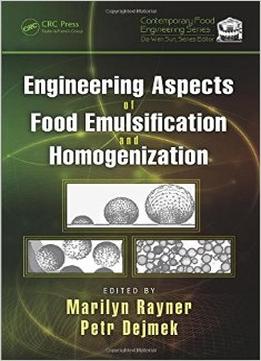
Engineering Aspects Of Food Emulsification And Homogenization
by Marilyn Rayner /
2015 / English / PDF
15.6 MB Download
Emulsions are found in a wide variety of food products, pharmaceuticals, paints, and cosmetics, thus emulsification is a truly multidisciplinary phenomenon. Therefore understanding of the process must evolve from the combination of (at least) three different scientific specializations. Engineering Aspects of Food Emulsification and Homogenization describes the state-of-the-art technology and brings together aspects from physical chemistry, fluid mechanics, and chemical engineering. The book explores the unit operations used in emulsification and homogenization processes, using fundamental theory from different fields to discuss design and function of different emulsification techniques. This book summarizes the present understanding of the involved physical–chemical processes as well as specific information about the limits and possibilities for the different types of emulsifying equipment. It covers colloidal chemistry and engineering aspects of emulsification and discusses high-energy and low-energy emulsification methods. The chapters highlight low-energy emulsification processes such as membrane emulsification that are now industrially feasible. Dramatically more energy-efficient processes are being developed, and this book clarifies their present limitations, such us scale-up and achievable droplet sizes. The present literature on emulsification is, to a large degree, influenced by the division between physical chemistry, fluid dynamics, and chemical engineering. Written by experts drawn from academia and industry, this book brings those areas together to provide a comprehensive resource that gives a deeper understanding of emulsification and homogenization in food product development.











